October 26, 2021
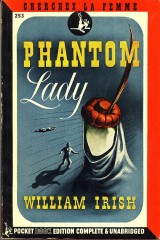 I went down a large Cornell Woolrich hole at one point in my life, and in some ways never came out (perhaps I’m not in as deep as I once was, which isn’t to say my liking of books by said author is less, but maybe to say I’ve read such a fair amount of those available that there aren’t that many more readily available) – heck, check out the past Cornell Woolrich Cocktail Talks for evidence. There are a fair few of them! You’ll get lots of background on this, the noir-y-est (in many ways – I mean, no mystery writer uses the word “black” in more titles for a start, but also he’s such a master of psychological dark moods and mental, as well as action-driven, thrillers that seem going down a dark path) of the pulp writers, perhaps. He also wrote under a couple pseudonyms, the best-known being William Irish, under-which name he became famous enough that I have a copy of The Best of William Irish which I was recently re-reading. Featuring two full-length reads and a handful of stories, the book’s highlight may well be “Rear Window” (from which the legendary movie was made, which you should re-watch right now), which, funny enough, I think was pub’d under Cornell’s own name originally (and originally called “It Had to be Murder”). But if you have a story which a famous movie is based on, you work it in. The whole collection starts with perhaps the most famous William Irish-monikered tale (though that could be debated), the novel Phantom Lady, which I am also lucky enough to have as a standalone book, and which was also made into a movie in 1944, a movie I haven’t seen, but would love to! The book’s chapters all countdown to an execution (28 Days Before the Execution, etc.), which gives an insight into the plot: a man is accused – falsely, we know – of the murder of his wife, with only one possible way to convince the police he’s innocent, finding of a missing woman who can place him at a bar at a particular time. It’s a good read and then some, keeping you moving and twisting around this way and that way, with a few more murders and lots of surprises. Having a bar with a key role doesn’t hurt, either, and neither does the mention of Jack Rose cocktails, among others, in the below Cocktail Talk quote.
I went down a large Cornell Woolrich hole at one point in my life, and in some ways never came out (perhaps I’m not in as deep as I once was, which isn’t to say my liking of books by said author is less, but maybe to say I’ve read such a fair amount of those available that there aren’t that many more readily available) – heck, check out the past Cornell Woolrich Cocktail Talks for evidence. There are a fair few of them! You’ll get lots of background on this, the noir-y-est (in many ways – I mean, no mystery writer uses the word “black” in more titles for a start, but also he’s such a master of psychological dark moods and mental, as well as action-driven, thrillers that seem going down a dark path) of the pulp writers, perhaps. He also wrote under a couple pseudonyms, the best-known being William Irish, under-which name he became famous enough that I have a copy of The Best of William Irish which I was recently re-reading. Featuring two full-length reads and a handful of stories, the book’s highlight may well be “Rear Window” (from which the legendary movie was made, which you should re-watch right now), which, funny enough, I think was pub’d under Cornell’s own name originally (and originally called “It Had to be Murder”). But if you have a story which a famous movie is based on, you work it in. The whole collection starts with perhaps the most famous William Irish-monikered tale (though that could be debated), the novel Phantom Lady, which I am also lucky enough to have as a standalone book, and which was also made into a movie in 1944, a movie I haven’t seen, but would love to! The book’s chapters all countdown to an execution (28 Days Before the Execution, etc.), which gives an insight into the plot: a man is accused – falsely, we know – of the murder of his wife, with only one possible way to convince the police he’s innocent, finding of a missing woman who can place him at a bar at a particular time. It’s a good read and then some, keeping you moving and twisting around this way and that way, with a few more murders and lots of surprises. Having a bar with a key role doesn’t hurt, either, and neither does the mention of Jack Rose cocktails, among others, in the below Cocktail Talk quote.
He said, “I had a Scotch and water. I always have that, never anything else. Give me just a minute now, to see if I can get hers. It was all the way down near the bottom –“
The barman came back with a large tin box.
Henderson said, rubbing his forehead, “There was a cherry left in the bottom of the glass and – “
“That could be any one of six drinks. I’ll get it for you. Was the bottom stemmed or flat? And what color was the dregs? If it was a Manhattan the glass was stemmed and dregs, brown.”
Henderson said, “It was a stem-glass, she was fiddling with it. But the dregs weren’t brown, now, they were pink, like.”
“Jack Rose,” said the barman briskly. “I can get it for you easy, now.”
–Cornell Woolrich (writing as William Irish), Phantom Lady
Tags: apple brandy, applejack, Bars, Cocktail Talk, Cornell Woolrich, grenadine, Jack Rose, lemon, Manhattan, Phantom Lady, Scotch, Scotch and water, sweet vermouth, Whiskey, William Irish
Posted in: Bars, Brandy, Cocktail Talk, Manhattan, Scotch, vermouth, Whiskey
October 19, 2021
 It’s a smidgen odd that I haven’t had more Peter Lovesey Cocktail Talks here on the ol’ Spiked Punch, just as I read and re-read his books (especially his Peter Diamond mysteries) as much as nearly any written words. Though, on the flip side, he doesn’t dwell in the bars and boozes as much as some, so maybe not so strange? Anyway, before I ramble so far we end up lost in the English countryside, today we are having a Lovesey Cocktail Talk, with a quote from the story “Bullets,” which I recently re-read when I was re-reading his killer (hahaha) collection, Murder on the Short List, a collection full of mysteries and mysterious deaths, some featuring a couple of his classic characters and some not. While I may shade my favoritism towards the longer works, many like his stories best, and he is a master – all of which is to say, pick this book up if you see it. This particular short story starts with an inspector getting ready to talk to the relatives of man found dead in his study, supposedly (!) by suicide.
It’s a smidgen odd that I haven’t had more Peter Lovesey Cocktail Talks here on the ol’ Spiked Punch, just as I read and re-read his books (especially his Peter Diamond mysteries) as much as nearly any written words. Though, on the flip side, he doesn’t dwell in the bars and boozes as much as some, so maybe not so strange? Anyway, before I ramble so far we end up lost in the English countryside, today we are having a Lovesey Cocktail Talk, with a quote from the story “Bullets,” which I recently re-read when I was re-reading his killer (hahaha) collection, Murder on the Short List, a collection full of mysteries and mysterious deaths, some featuring a couple of his classic characters and some not. While I may shade my favoritism towards the longer works, many like his stories best, and he is a master – all of which is to say, pick this book up if you see it. This particular short story starts with an inspector getting ready to talk to the relatives of man found dead in his study, supposedly (!) by suicide.
They were sitting at the kitchen table in 7, Albert Street, their small suburban house in Teddington. They had a bottle of brandy between them.
The inspector accepted a drink and knocked it back in one swig. When talking to the recently bereaved he needed all the lubrication he could get.
–Peter Lovesey, “Bullets”
August 17, 2021
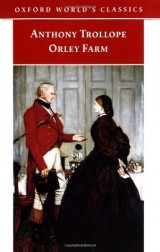 You may have thought it couldn’t be done, but we’re back to Orley Farm after our cinematic sidestep last week, and I’m going to have one more Mr. Moulder Cocktail Talk from the Trollope novel (I may have more Cocktail Talks from the book that don’t feature him, too. Only time will tell pals, and even it might not know!). But we’ve had a few of him in his higher moments, and so I only felt it was right to have one when he’s snoozing away after a long day shilling for Hubbles and Grease and swilling brandy and water (and perhaps other potent potables, too). However, it’s the description of his waking in the below quote that does the most for me. Oh, before I forget! Don’t miss the Orley Farm Cocktail Talks Part I, Part II, and Part III for more about the book itself, and all the Anthony Trollope Cocktail Talks (there are a few!) for more Trollopean fun.
You may have thought it couldn’t be done, but we’re back to Orley Farm after our cinematic sidestep last week, and I’m going to have one more Mr. Moulder Cocktail Talk from the Trollope novel (I may have more Cocktail Talks from the book that don’t feature him, too. Only time will tell pals, and even it might not know!). But we’ve had a few of him in his higher moments, and so I only felt it was right to have one when he’s snoozing away after a long day shilling for Hubbles and Grease and swilling brandy and water (and perhaps other potent potables, too). However, it’s the description of his waking in the below quote that does the most for me. Oh, before I forget! Don’t miss the Orley Farm Cocktail Talks Part I, Part II, and Part III for more about the book itself, and all the Anthony Trollope Cocktail Talks (there are a few!) for more Trollopean fun.
Soon after that Mr. Kenneby saw Mrs. Smiley home in a cab, and poor Mrs. Moulder sat by her lord till he roused himself from his sleep. Let us hope that her troubles with him were as little vexatious as possible; and console ourselves with the reflection that at twelve o’clock the next morning, after the second bottle of soda and brandy, he was ‘as sweet as sweet.’
–Anthony Trollope, Orley Farm
July 20, 2021
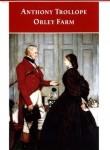 Our third Orley Farm Cocktail Talk revisits a character introduced in Part II (for more on the overall book, see Part I, and for more Trollopean fun, see all past Anthony Trollope Cocktail Talks), traveling salesman for Hubbles and Grease, Mr. Moulder. In this quote, we find our rotund commercial traveler at home for Christmas celebrations, where he and his missus are hosting a few others for a big feast, and where Mr. Moulder is talking of the liquid possibilities for the day, specifically brandy and a special whiskey,
Our third Orley Farm Cocktail Talk revisits a character introduced in Part II (for more on the overall book, see Part I, and for more Trollopean fun, see all past Anthony Trollope Cocktail Talks), traveling salesman for Hubbles and Grease, Mr. Moulder. In this quote, we find our rotund commercial traveler at home for Christmas celebrations, where he and his missus are hosting a few others for a big feast, and where Mr. Moulder is talking of the liquid possibilities for the day, specifically brandy and a special whiskey,
And then, as for drink, —”tipple,” as Mr. Moulder sportively was accustomed to name it among his friends, he opined that he was not altogether behind the mark in that respect. “He had got some brandy—he didn’t care what anybody might say about Cognac and eau de vie; but the brandy which he had got from Betts’ private establishment seventeen years ago, for richness of flavour and fullness of strength, would beat any French article that anybody in the city could show. That at least was his idea. If anybody didn’t like it, they needn’t take it. There was whisky that would make your hair stand on end.” So said Mr. Moulder, and I can believe him; for it has made my hair stand on end merely to see other people drinking it.
— Anthony Trollope, Orley Farm
July 13, 2021
 Welcome to the second part of our tipsy tour through the Anthony Trollope novel Orley Farm (don’t miss Part I, or any of the past Anthony Trollope Cocktail Talks). In the first part, I chatted a smidge about the novel itself, and where it slots into my own personal Trollope-verse, if you will. One thing I didn’t mention there, however, is perhaps my top character in the book, a commercial traveler (or traveling salesman, if you will), named Mr, Moulder, a lover of food and drink and a representative of the fine old firm of Hubbles and Grease, purveyors of find coffee, tea, and brandy. Randomly showing up when one of the novel’s major players stops at a fine old English inn, The Bull, Mr. Moulder shows up again, and I was happier for it. But the below quote (they’ll be more from our Mr. Moulder) is in his introduction graph, and gives a nice view into him, if you will.
Welcome to the second part of our tipsy tour through the Anthony Trollope novel Orley Farm (don’t miss Part I, or any of the past Anthony Trollope Cocktail Talks). In the first part, I chatted a smidge about the novel itself, and where it slots into my own personal Trollope-verse, if you will. One thing I didn’t mention there, however, is perhaps my top character in the book, a commercial traveler (or traveling salesman, if you will), named Mr, Moulder, a lover of food and drink and a representative of the fine old firm of Hubbles and Grease, purveyors of find coffee, tea, and brandy. Randomly showing up when one of the novel’s major players stops at a fine old English inn, The Bull, Mr. Moulder shows up again, and I was happier for it. But the below quote (they’ll be more from our Mr. Moulder) is in his introduction graph, and gives a nice view into him, if you will.
He wore no beard, and therefore showed plainly the triple bagging of his fat chin. In spite of his overwhelming fatness, there was something in his face that was masterful and almost vicious. His body had been overcome by eating, but not as yet his spirit—one would be inclined to say. This was Mr. Moulder, well known on the road as being in the grocery and spirit line; a pushing man, who understood his business, and was well trusted by his firm in spite of his habitual intemperance. What did the firm care whether or no he killed himself by eating and drinking? He sold his goods, collected his money, and made his remittances. If he got drunk at night that was nothing to them, seeing that he always did his quota of work the next day. But Mr. Moulder did not get drunk. His brandy and water went into his blood, and into his eyes, and into his feet, and into his hands, —but not into his brain.
–Anthony Trollope, Orley Farm
March 19, 2021
You ever wake up and think to yourself as the mists of Morpheus (hahaha, that’s deep yo) roll away from your ever-loving brain, “what I really want to do today is have a Stinger?” I’m sure you, as most, do. Because, though this might be too, oh, lace-doily-y for many at first glance (crème de menthe not having that renaissance that many liquids have been having oh these last 20 odd years), when that “many,” or most of many at least, realize the hefty shot of brandy this is based on, one hopes they take a second look, realize not every drink needs like 6 or 10 obscurities to be tasty, then follows that up with a realization that maybe some of those lace-doily lovers had a good idea of a good drink, and then these smart people make one of these, love it, and at a future date go through the morning ritual described above. At that point, the only question is: at what point in the day should you have said Stinger? And the answer is: right now, friend, right now.
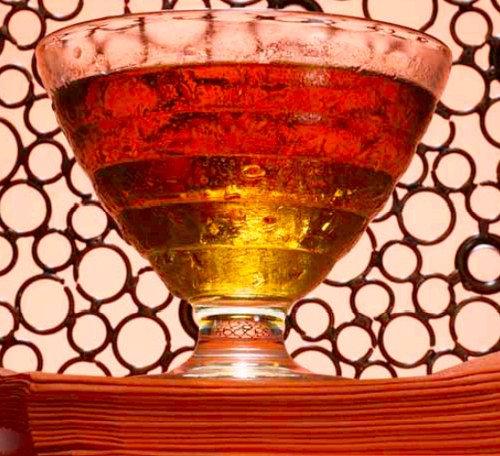
The Stinger (using the recipe from Dark Spirits)
Ice cubes or cracked ice (depending on if you’re stirring or shaking, see Step 1 below)
2-1/2 ounces brandy (or Cognac, if the bottle and desire and daring is nearby)
1/2 ounce white crème de menthe
1. Fill a cocktail shaker halfway full with ice cubes. Add the brandy and crème de menthe. Stir well, or shake. Honestly, I like to stir here, in traditionally manner. But, I also think this is one drink that needs to be well-chilled. So, do what’s best.
2. Strain the mix into a cocktail glass. Bee-lieve it!
Tags: bee puns, Brandy, cocktail, Cocktail Recipes, Crème de menthe, Friday Night Cocktail, The Stinger, What I’m Drinking
Posted in: Brandy, Cocktail Recipes, Dark Spirits, Liqueurs, Recipes, What I'm Drinking
February 2, 2021
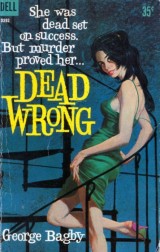 Recently decided that I was going to pick a random pocket book (here not specifically the company that shares that name, but the in-general usually, well, pocket-sized books popular mid-last-century, often leaning towards pulp-i-ness, but not always) from the stacks of them on one of my bookshelves, and ended up grabbing Dead Wrong, by George Bagby, pub’d by Dell way back in 1957. Featuring Bagby’s Inspector Schmidt and the author himself (one of the more interesting things in the Bagby canon is how he is in the books, just hanging with the Inspector and writing up his cases – things were looser in the police force back then), there’s the murder of a dancer, a short-but-curious list of possible suspects, and a few twists and turns. Not the most exciting of the genre, but worth a look, especially for the absolutely knock-out cover, with the knocking-out provided by (for me, at least) not just by the green-dress’d lady, but by the cool copy treatment. I would love to have that as a font option! It’s amazing. Oh, there are also a couple Cocktail Moments, highlighted by the below sleep cure. But that cover copy! The cover painting was by (according to the back cover), a Robert McGinnis, and Robert (wherever you may be), if you did the copy too, you are a genius!
Recently decided that I was going to pick a random pocket book (here not specifically the company that shares that name, but the in-general usually, well, pocket-sized books popular mid-last-century, often leaning towards pulp-i-ness, but not always) from the stacks of them on one of my bookshelves, and ended up grabbing Dead Wrong, by George Bagby, pub’d by Dell way back in 1957. Featuring Bagby’s Inspector Schmidt and the author himself (one of the more interesting things in the Bagby canon is how he is in the books, just hanging with the Inspector and writing up his cases – things were looser in the police force back then), there’s the murder of a dancer, a short-but-curious list of possible suspects, and a few twists and turns. Not the most exciting of the genre, but worth a look, especially for the absolutely knock-out cover, with the knocking-out provided by (for me, at least) not just by the green-dress’d lady, but by the cool copy treatment. I would love to have that as a font option! It’s amazing. Oh, there are also a couple Cocktail Moments, highlighted by the below sleep cure. But that cover copy! The cover painting was by (according to the back cover), a Robert McGinnis, and Robert (wherever you may be), if you did the copy too, you are a genius!
The inspector introduced the two young men. Jack Champlin reached for the brandy bottle. He asked Andy if he would join him. Andy did.
“I’m not making myself drunk Inspector,” Jack said as he poured the brandy. “I seem to be using this instead of sleep tonight.”
–George Bagby, Dead Wrong
November 24, 2020
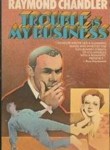 We’re still taking our fall tour along Raymond Chandler lane (don’t miss the “Trouble Is My Business” Part I and Part II Cocktail Talks), with Raymond Chandler of course, and have now made it to Seattle – which, coincidentally, is where I tend to sometimes hang my hat. So, as you can imagine, when I read the story “Goldfish,” in the book Trouble Is My Business and Other Stories, and Chandler’s PI Philip Marlowe ended up heading to Seattle, WA, well, I was tickled. And then they drank apple brandy! And then fish, and before that a mystery long-told, and I won’t want to say anymore cause you need to read the story – if I haven’t sold it, this quote will.
We’re still taking our fall tour along Raymond Chandler lane (don’t miss the “Trouble Is My Business” Part I and Part II Cocktail Talks), with Raymond Chandler of course, and have now made it to Seattle – which, coincidentally, is where I tend to sometimes hang my hat. So, as you can imagine, when I read the story “Goldfish,” in the book Trouble Is My Business and Other Stories, and Chandler’s PI Philip Marlowe ended up heading to Seattle, WA, well, I was tickled. And then they drank apple brandy! And then fish, and before that a mystery long-told, and I won’t want to say anymore cause you need to read the story – if I haven’t sold it, this quote will.
“Too early for apple brandy, ain’t it?” he whispered.
I told him how wrong he was. He went away again and came back with glasses and a quart of clear amber fluid. He sat down with me and poured. A rich baritone voice in the kitchen was singing “Chloe,” over the sizzling.
We clinked glasses and drank and waited for the heat to crawl up our spines.
“Stranger, ain’t you?” the little man asked.
I said I was.
“From Seattle maybe? That’s a nice piece of goods you got on.”
“Seattle,” I agreed.
— Raymond Chandler, “Goldfish”
 I went down a large Cornell Woolrich hole at one point in my life, and in some ways never came out (perhaps I’m not in as deep as I once was, which isn’t to say my liking of books by said author is less, but maybe to say I’ve read such a fair amount of those available that there aren’t that many more readily available) – heck, check out the past Cornell Woolrich Cocktail Talks for evidence. There are a fair few of them! You’ll get lots of background on this, the noir-y-est (in many ways – I mean, no mystery writer uses the word “black” in more titles for a start, but also he’s such a master of psychological dark moods and mental, as well as action-driven, thrillers that seem going down a dark path) of the pulp writers, perhaps. He also wrote under a couple pseudonyms, the best-known being William Irish, under-which name he became famous enough that I have a copy of The Best of William Irish which I was recently re-reading. Featuring two full-length reads and a handful of stories, the book’s highlight may well be “Rear Window” (from which the legendary movie was made, which you should re-watch right now), which, funny enough, I think was pub’d under Cornell’s own name originally (and originally called “It Had to be Murder”). But if you have a story which a famous movie is based on, you work it in. The whole collection starts with perhaps the most famous William Irish-monikered tale (though that could be debated), the novel Phantom Lady, which I am also lucky enough to have as a standalone book, and which was also made into a movie in 1944, a movie I haven’t seen, but would love to! The book’s chapters all countdown to an execution (28 Days Before the Execution, etc.), which gives an insight into the plot: a man is accused – falsely, we know – of the murder of his wife, with only one possible way to convince the police he’s innocent, finding of a missing woman who can place him at a bar at a particular time. It’s a good read and then some, keeping you moving and twisting around this way and that way, with a few more murders and lots of surprises. Having a bar with a key role doesn’t hurt, either, and neither does the mention of Jack Rose cocktails, among others, in the below Cocktail Talk quote.
I went down a large Cornell Woolrich hole at one point in my life, and in some ways never came out (perhaps I’m not in as deep as I once was, which isn’t to say my liking of books by said author is less, but maybe to say I’ve read such a fair amount of those available that there aren’t that many more readily available) – heck, check out the past Cornell Woolrich Cocktail Talks for evidence. There are a fair few of them! You’ll get lots of background on this, the noir-y-est (in many ways – I mean, no mystery writer uses the word “black” in more titles for a start, but also he’s such a master of psychological dark moods and mental, as well as action-driven, thrillers that seem going down a dark path) of the pulp writers, perhaps. He also wrote under a couple pseudonyms, the best-known being William Irish, under-which name he became famous enough that I have a copy of The Best of William Irish which I was recently re-reading. Featuring two full-length reads and a handful of stories, the book’s highlight may well be “Rear Window” (from which the legendary movie was made, which you should re-watch right now), which, funny enough, I think was pub’d under Cornell’s own name originally (and originally called “It Had to be Murder”). But if you have a story which a famous movie is based on, you work it in. The whole collection starts with perhaps the most famous William Irish-monikered tale (though that could be debated), the novel Phantom Lady, which I am also lucky enough to have as a standalone book, and which was also made into a movie in 1944, a movie I haven’t seen, but would love to! The book’s chapters all countdown to an execution (28 Days Before the Execution, etc.), which gives an insight into the plot: a man is accused – falsely, we know – of the murder of his wife, with only one possible way to convince the police he’s innocent, finding of a missing woman who can place him at a bar at a particular time. It’s a good read and then some, keeping you moving and twisting around this way and that way, with a few more murders and lots of surprises. Having a bar with a key role doesn’t hurt, either, and neither does the mention of Jack Rose cocktails, among others, in the below Cocktail Talk quote.


























